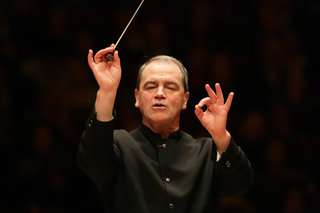|
Back
Season Opener Revels in Russian Spectacle Houston
Jones Hall
09/16/2010 - & September 18, 19, 2010
Igor Stravinsky: Le Chant du rossignol
Dmitri Shostakovich: Symphony No. 1 in F Minor, Op. 10
Pyotr Ilyich Tchaikovsky: Piano Concerto No. 1 in B-flat Minor, Op. 23
Yefim Bronfman (piano)
Houston Symphony, Hans Graf (conductor) 
H. Graf ( © Chris Lee)
For the opening subscription concerto of the 2010-11 Houston Symphony Season, Hans Graf smartly played to his strengths. Joined by the aristocratic powerhouse pianist Yefim Bronfman, Graf and his orchestra delivered magnificent performances of a three Russian works. The playfully exotic Stravinsky tone poem, precociously confident Shostakovich symphony and indisputably seminal Tchaikovsky concerto celebrated the rich shared heritage of three countrymen who followed drastically different stylistic and career paths.
Stravinsky’s The Song of the Nightingale is a bit dangerous as a concert opener: twenty minutes of episodic orientalism can be a tough sell. Graf coaxed excellent solo work from the orchestra, most notably from the principal flute and trumpet, who negotiated their notoriously difficult solos with both technical and musical virtuosity. The vast majority of the sudden tempo changes were well-managed from the podium, and the HSO’s new concertmaster seems to have worked wonders in his short time with the orchestra. The strings seemed refreshed by his presence, playing with sharper rhythm, fuller sound and more accurate interplay. The program notes tried to convince one that this piece bears strong similarities to The Rite of Spring, but it is clear that Nightingale’s world is the culmination of the exoticism inspired by Rimsky-Korsakov, especially in sonic devices, reaching back to the elder Russian’s Le Coq d’or and tracing a straight line through Igor’s own Scherzo fantastique, Firebird and Petrushka. The Rite’s eschewing of the essential harp/celesta timbre that forms the backbone of these Stravinsky scores proves this. The audience clearly delighted in Stravinsky’s ingenious orchestral effects, but it was clear that by the midpoint some interest had been lost, and even in a performance as fine as this was, the piece becomes difficult to appreciate after a point, especially without choreography or the vocal fireworks of the original opera.
Shostakovich’s First Symphony followed, drawing us into a harsher, more crystallized musical style. The work again provided ample opportunity for the orchestra’s wind soloists (bassoon and trumpet were particularly fine here) and allowed the brass section to finally let loose after their unrequited buildups in the Stravinsky. There seemed to be a bit of confusion in the orchestra at the opening of the second movement, which came close to a derailment, but the ensemble quickly congealed. The transition out of the first meno mosso back to the Allegro showed that this was the exception to otherwise fine discipline and taut leadership from the podium. These two opening works neatly foreshadow the next subscription concert. Stravinsky’s remolding of his opera into a symphonic poem and the veiled Wagner quotations in the youthful Shostakovich’s symphony hint at the symphonic adaptations of operas by John Adams and Wagner that will be featured next. While it was nice to hear the rarely-performed tone poem Baba Yaga by Anatoly Liadov as an encore, it was a bit gratuitous to ask a contrabassoonist and bass clarinetist to play for four minutes and somewhat curious to present this excellent, unknown work without any documentation in the program. One hopes that this, too, was a hint at future programming?
After intermission, Yefim Bronfman gave an athletic, powerful rendition of Tchaikovsky’s Piano Concerto No. 1. Bronfman’s first movement cadenza was especially fine, with consistently differentiated lines warmed with ample pedaling and dynamic shading. Graf seemed reluctant to follow Bronfman’s desire to push ahead in the first movement, and this slight interpretive difference of opinion became more pronounced in the finale, especially at the molto più mosso, where pianist put the pedal to the metal while orchestra continued on cruise control. The second movement was lovely. Bronfman and the flute and oboe soloists played the andante melody with true simplicity as indicated, and the central prestissimo was tossed off by Bronfman with staggeringly subtle agility.
Marcus Karl Maroney
|